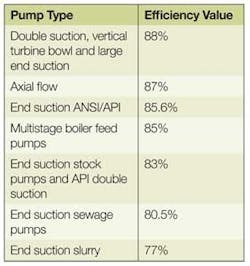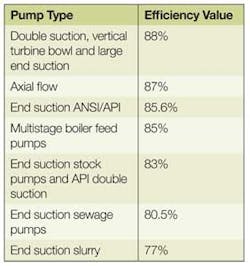Power Points: An Overview of Pump System Energy Savings Methods and Opportunities
By Allan R. Budris, P.E.
Introduction
Numerous municipal water and wastewater pumping systems offer major potential for energy savings. Water and wastewater facilities account for up to 40 percent of municipal energy usage, with pumping accounting for 20 to 45 percent of this. In fact, pump system energy draw at wastewater treatment plants is typically second only to aeration. Studies report that savings of 15 to 30 percent are readily achievable, based on the fact that the average overall municipal pump system efficiencies are reported to be only about 32 percent.
Given this fertile potential for energy/cost savings and the fact that 22 of my past columns (over a seven-year period) have touched on a variety of ways to improve pump system efficiency, I have organized and summarized these efficiency-related recommendations into the following concise overview.
Energy Management Program
The first step toward achieving potential energy savings should be to establish a formal, facility-wide "energy reduction" program, which is supported and backed by management, with specific objectives and resources established. Such a program should typically consist of the following distinct phases:
- Define: The first phase in this process is the most difficult and critical. It must clearly define the criteria that the pumping system should accomplish (why it exists) and explain what is negotiable and what is not. Further, the project boundaries (scope, goals, expectations, and payback) must be defined. And most importantly, the support personnel and resources must be identified. To optimize resource utilization, the pumping systems should be screened and the systems with the greatest savings potential identified.
- Measure: Once the project has been fully defined, the specific cost reduction actions can start, with this next phase focusing on collecting the necessary detailed information on the pump system(s) that have been identified as having the greatest cost-savings potential. The collected system information/data should allow for a full energy cost analysis of all the major pump system components.
- Analyze: Once all the required measurements have been taken and the necessary data collected, it is time to analyze the results to identify gaps between the current performance, goals (objectives) and potential energy-savings alternatives.
- Improve: After the results have been analyzed, goals established and alternatives identified, the next step is to select, design and execute the improvement(s) after obtaining the all-important management approvals.
- Control: Most improvement programs do not go beyond the improvement phase; however, it is important to follow up on the improvement actions to insure that the savings have been accomplished and/or to learn from any deviations from the expected results.
Pump System Approach
It is important to look at the full chain of elements that are involved in the overall energy flow of a pumping system. Each element and/or interface adds some inefficiency. The goal should be to maximize the overall efficiency, which is the product of the efficiency of each system energy transfer or conversion devices. There is normally much more potential in the proper application of a pump and the system design than just the pump efficiency alone. Elements to consider include:
- Electric utility feeder lines (higher voltages and increased power factors reduce these losses)
- Transformer
- Motor breaker/starter
- Adjustable-speed/variable frequency drive (VFD), if provided
- Motor (available in various efficiency ratings)/motor load (over and under voltage and voltage unbalance can reduce operating efficiency)
- Coupling
- Pump (note that this is only one of the elements)
- Fluid system (includes control valves and piping that determine the friction loss)
- Ultimate goal (flow rate at a given static head increase)
System Element Cost Factors
Pump Selection
With regard to pump selection, it's important to:
- Select pumps to operate close to their best efficiency (BEP) flow rate. Consider adding a smaller pump to handle periods of low demand.
- Eliminate over-sizing by proper use of margins. One of the most serious wastes of power involves the traditional practice of over-sizing a pump by selecting design conditions with excessively "conservative" margins in both capacity and total head.
- Optimize the specific speed, if feasible. This governs the basic geometry of the impeller. It also dictates the maximum obtainable pump efficiency that occurs at specific speed values between 2,000 and 3,000.
Pump Construction and Features
Pump type also dictates the maximum obtainable efficiency, as detailed below, with specialty pumps having some of the lowest values. Where applicable, the use of specialty pumps should, therefore, be limited. These generally- attainable centrifugal pump-type efficiency values are presented at the optimum specific speed (2,500 – 3,000) and a BEP flow rate of 3,500 gpm.
Pump Drives
Use more efficient motors: Optimizing pump motor efficiency can provide meaningful lifecycle cost savings over the life of the pump/motor. The key factors that impact the efficiency of an induction motor are:
- Motor relative load (motors that are oversized and under-loaded have lower efficiencies and power factors)
- Motor speed (numbers of poles)
- Motor size (power rating)
- Motor class: standard-efficiency vs. energy-efficiency vs. premium-efficiency
- Low power factors: These can increase a facility's electrical costs through utility penalties and/or higher line losses. They can be improved through the use of "power factor correction capacitors" or VFD drives.
- Submersible (wet or dry pit) motor: Efficiency is typically measurably less and the power draw higher than for a typical dry pit standard air-cooled motor. This efficiency penalty can, however, be mitigated by the use of one of the newer, more efficient, submersible dry pit pumps.
Multi- or Variable-Speed Motors or Other Variable-Speed Devices
- Variable frequency: Replace the control valve with a VFD, which can markedly reduce the pump power draw. VFDs are ideal for varying flow or head conditions in systems with lower static head components.
- Hybrid control: This involves adding bypass flow to a variable-speed device (VSD) control system, which can allow the pump to operate much closer to its BEP flow rate, even during periods of low system demand.
- Adjustable speed permanent magnetic couplings (PMD): These are the latest, more efficient version of the eddy current (magnetic slip) coupling. Although the efficiency of a PMD is somewhat less than for a VFD at moderate to higher speed turndowns, they can still save substantial energy and maintenance costs. Further, they might have a somewhat lower total cost and could be easier to justify than a VFD.
Pump Control Methods
Probably the most important decision that a pump user can make is selecting the best pump control method for an application in order to obtain the lowest pump system lifecycle cost. The most common centrifugal pump control methods are:
- Stop-start/float level control operation
- Control valve operation (the most popular but least efficient)
- Bypass valve operation (best with high specific speed pumps)
- Variable-speed operation (see above)
- Hybrid control (VFD + bypass, see above)
- Parallel operation of multiple pumps
- Multiple-speed motors (2, 3 or 4 speed)
Maintenance
A few simple maintenance activities can have a substantial impact on pump efficiency.
- Renew internal clearances: Replacing worn pump wearing rings is normally a relatively easy fix, which will not only improve the efficiency and head of a pump but will also increase the NPSH requirement by avoiding additional flow and turbulence entering the impeller eye. The lower the pump specific speed (lower flow/higher head), the greater the impact of increased wearing ring clearance on the pump performance. There are also non-galling composite materials, such as DuPont's Vespel CR-6100 and wearing ring grooves, that will allow the wearing ring clearances to be reduced below the manufacturer's specification, saving even more energy and further reducing the NPSHR.
- Recondition waterways: There are many after-market methods for reconditioning worn pump casing and/or impeller internal fluid passages, including wire brushing, sand/grit blasting and coatings. Interior coatings can recover 70 to 80 percent of the friction losses and 5 to 10 percent of the pump efficiency.
Field Changes and Operation
How a pump is operated can have a sizable impact on overall energy costs.
- Parallel pumps: These can be operated in a variety of combinations and flow rates. To minimize energy costs, the most energy-effective (GPM/kW) pump(s) should be operated near their maximum flow rate. Shut down unnecessary pumps.
- Replace existing oversized pumps and drivers: Once the pump system is operational, it is now possible to establish the true system-head curve by running a field performance test. Replacement of oversized pumps and drivers with smaller, more efficient counterparts can be evaluated.
- Trim the impellers: The existing impeller can often be cut down to meet the real service conditions required for the installation - a low-cost action.
- Replace the impeller with a better system match: If two separate impeller designs are available for the same pump, one with a narrower width might better match a lower flow rate application. Such a narrow impeller would typically have its best efficiency at a lower capacity than the normal-width impeller.
- Hydraulic turbines: Most centrifugal pump can run in reverse as a hydraulic power recovery turbine (HPRT), with efficiencies equal or close to that of the pump mode. In addition to pure hydropower applications, HPRTs can be used to replace brake-down valves in the pump discharge or bypass lines to recover otherwise wasted energy.
Conclusion
As can be seen, there is substantial potential for large energy savings from drinking water and wastewater pumping system analyses and upgrades, but it is a complex issue. A detailed approach has been presented to systematically address the many issues associated with municipal and other pump systems and to help achieve the maximum possible energy cost savings.
About the Author: Allan R. Budris, P.E., is an independent consulting engineer who specializes in training, failure analysis, troubleshooting, reliability, efficiency audits, and litigation support on pumps and pumping systems. He can be contacted via email at [email protected].

